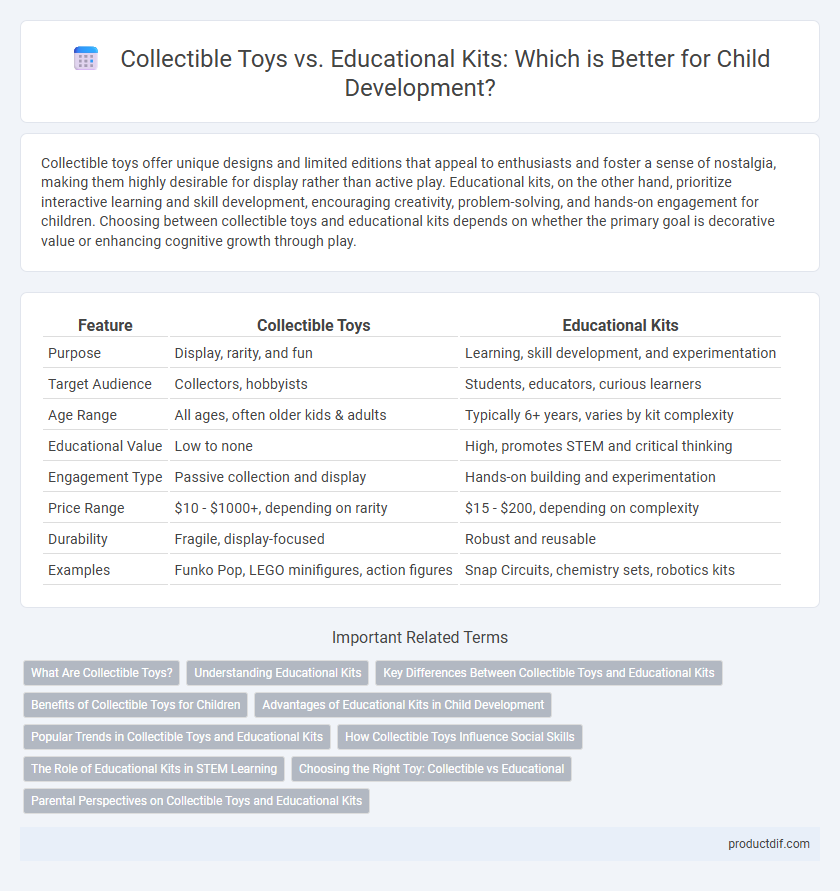Collectible toys offer unique designs and limited editions that appeal to enthusiasts and foster a sense of nostalgia, making them highly desirable for display rather than active play. Educational kits, on the other hand, prioritize interactive learning and skill development, encouraging creativity, problem-solving, and hands-on engagement for children. Choosing between collectible toys and educational kits depends on whether the primary goal is decorative value or enhancing cognitive growth through play.
Table of Comparison
| Feature | Collectible Toys | Educational Kits |
|---|---|---|
| Purpose | Display, rarity, and fun | Learning, skill development, and experimentation |
| Target Audience | Collectors, hobbyists | Students, educators, curious learners |
| Age Range | All ages, often older kids & adults | Typically 6+ years, varies by kit complexity |
| Educational Value | Low to none | High, promotes STEM and critical thinking |
| Engagement Type | Passive collection and display | Hands-on building and experimentation |
| Price Range | $10 - $1000+, depending on rarity | $15 - $200, depending on complexity |
| Durability | Fragile, display-focused | Robust and reusable |
| Examples | Funko Pop, LEGO minifigures, action figures | Snap Circuits, chemistry sets, robotics kits |
What Are Collectible Toys?
Collectible toys are limited-edition or themed items designed primarily for display and value appreciation rather than active play. These toys often represent popular franchises, nostalgic characters, or rare designs that appeal to hobbyists and enthusiasts. Their intricate details and brand collaborations create a unique market distinct from educational kits that emphasize learning and skill development.
Understanding Educational Kits
Educational kits provide interactive learning experiences, combining hands-on activities with STEM concepts to enhance cognitive development in children. These kits often include experiments, building projects, and problem-solving challenges that foster creativity and critical thinking skills. Unlike collectible toys, which emphasize display and nostalgia, educational kits prioritize skill-building and knowledge acquisition through active participation.
Key Differences Between Collectible Toys and Educational Kits
Collectible toys emphasize rarity, design, and brand value, often appealing to hobbyists and investors seeking unique or limited-edition items. Educational kits prioritize skill development, interactive learning, and cognitive growth, targeting children and educators aiming to enhance STEM skills through hands-on activities. The key difference lies in collectible toys as objects of value and display, while educational kits serve as practical tools for knowledge acquisition and skill-building.
Benefits of Collectible Toys for Children
Collectible toys enhance children's creativity and imagination by encouraging storytelling and role-playing, fostering cognitive and social development. They provide a sense of achievement and responsibility through collecting, organizing, and caring for items, boosting self-esteem and organizational skills. Exposure to diverse themes and genres in collectible toys also nurtures curiosity and cultural awareness in children.
Advantages of Educational Kits in Child Development
Educational kits foster cognitive growth by engaging children in hands-on learning activities that enhance problem-solving and critical thinking skills. These kits often incorporate STEM concepts, promoting scientific curiosity and mathematical understanding more effectively than collectible toys. By encouraging creativity and practical application, educational kits support comprehensive child development in both academic and social domains.
Popular Trends in Collectible Toys and Educational Kits
Collectible toys such as Funko Pops and LEGO minifigures dominate market trends, driven by nostalgia and pop culture fandoms, while educational kits like STEM robotics sets and science experiment boxes gain traction for enhancing learning through interactive play. Recent sales data show a 25% annual growth in collectible toys linked to limited editions and franchise collaborations, contrasting with a 30% surge in educational kits emphasizing coding and engineering skills for children aged 6 to 12. Consumer interest increasingly favors toys combining entertainment with skill development, reflecting a dual demand for both play value and educational benefits.
How Collectible Toys Influence Social Skills
Collectible toys foster social skills by encouraging children to engage in shared interests, trading, and collaborative play, which enhances communication and negotiation abilities. These toys often create communities where kids develop friendships and learn teamwork, empathy, and conflict resolution. Unlike educational kits that focus on individual learning, collectible toys emphasize social interaction and peer bonding through common enthusiasm.
The Role of Educational Kits in STEM Learning
Educational kits play a crucial role in STEM learning by providing hands-on experiences that enhance critical thinking and problem-solving skills. These kits often include components for experiments and projects in science, technology, engineering, and mathematics, making complex concepts more accessible and engaging for students. Collectible toys focus on display and hobby interests, whereas educational kits emphasize active learning and skill development essential for academic growth.
Choosing the Right Toy: Collectible vs Educational
Choosing the right toy depends on the child's interests and developmental goals; collectible toys like action figures or trading cards offer entertainment and social engagement, while educational kits such as science experiments or building blocks promote cognitive skills and creativity. Collectible toys often hold sentimental or monetary value, appealing to hobbyists and collectors, whereas educational kits foster learning by encouraging problem-solving and hands-on exploration. Balancing fun with educational benefits helps parents and caregivers select toys that both delight and support a child's growth.
Parental Perspectives on Collectible Toys and Educational Kits
Parental perspectives on collectible toys versus educational kits often center around developmental value and long-term engagement; while collectible toys appeal through nostalgia and aesthetic appeal, educational kits are favored for their hands-on learning opportunities and cognitive skill enhancement. Many parents view educational kits as investments in their child's growth, promoting critical thinking and creativity, whereas collectible toys are usually appreciated more for their emotional and social connections. Balancing these preferences, parents tend to encourage educational kits for consistent skill development while recognizing collectible toys as occasional rewards or hobby starters.
Collectible toys vs educational kits Infographic

 productdif.com
productdif.com